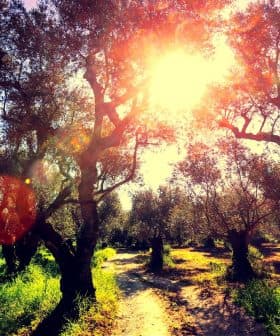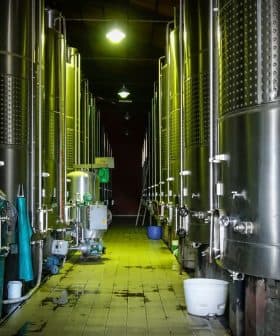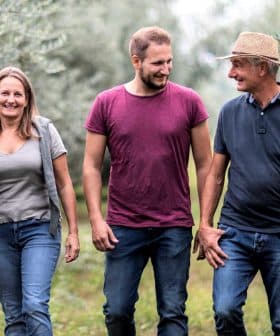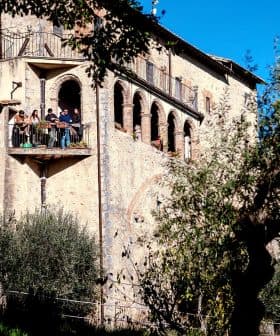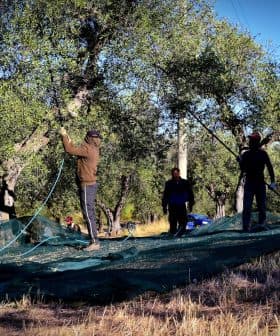 5.6K reads
5.6K readsFeatured
Leonardo Colavita and the UC Davis Olive Oil Report
The UC Davis Olive Center report on olive oil quality is viewed with suspicion in Italy, as most Italian and imported olive oils failed tests while nearly all California samples passed. The study, seen as protectionist, was financed by the California Olive Oil Council and California brands, and the Colavita company, featured in the study, expressed skepticism about the study’s methodology and results. The Colavita company, a high-profile Italian olive oil producer, conducts extensive internal testing and quality control measures to ensure the purity and quality of their olive oils, and the company has a strong commitment to maintaining their brand reputation.
With suspicion — that’s the way the olive oil world here in Italy is viewing the recent and controversial University of California, Davis Olive Center report. The study, performed in conjunction with the Australian Oils Research Laboratory, examined mass-market and store brand extra virgin olive oils, and those of California producers. Most Italian and imported olive oils failed sensory and chemical tests, while nearly all California samples passed. The study is seen as a way of making a market for California olive oil, and protectionist in spirit. That the research was financed by the California Olive Oil Council and two of the studied California brands, is seen as particularly telling.
The Italian press has had little coverage of the study. Il Salvagente, a consumer weekly, and Teatro Naturale, an online publication focusing on oil and wine, each ran a piece on the UC Study and discussed the validity of the tests, and both opined that the lopsided study favored California-produced extra virgin olive oil. For this piece, Colavita, Filippo Berio, Bertolli and Carapelli were all contacted for their views of the UC Davis study. Bertolli and Carapelli, historically Italian companies, are now owned by Grupo SOS, a Spanish company. By press time, only Colavita agreed to answer our questions regarding the study.
Enrico Colavita, who heads up the Colavita export office and operations in Campobasso, said via phone they had thought of releasing a statement on the UC Study, but decided against it since “it could produce even more confusion.” Asked about the general idea of testing extra virgin olive oil, he told Olive Oil Times that he welcomed testing, “Yes, we are in favor of testing, testing where the standards are agreed upon internationally, and also the methodology.” After a brief conversation and a couple of days, the writer was invited to the company’s Pomezia plant, in order to discuss the UC Davis Study and to view their facility. It is here that they package their extra virgin olive oil. The company is 24 kilometers (15 miles) from Rome, on the Via Laurentina, a southward leading ancient Roman road. Pomezia is largely industrial.

Andrea, Enrico, and Leonardo Colavita
Enrico Colavita, President and Leonardo Colavita, General Manager, are brothers and joint heads of the family firm. For generations, the Colavitas produced olive oil in Molise’s Campobasso province. Leonardo says of their town, “Sant’ Elia Pianisi has 2,000 inhabitants, and at least 30% have Colavita as their last name.” Their father went into the packaging of olive oil, distinct from growing and pressing olives. Leonardo’s son Giovanni is President of Colavita USA, and lives in New York; Leonardo’s daughter Carla works in a role which sounds like Chief Financial Officer and is now in New York for four months but is generally in Italy. Enrico’s son Andrea is Director of Sales; and his other son, Paolo, attends university in Rome, and will join the company after graduation. The company employs 60 people in Italy, and 70 in the US, what seem like very small numbers for such a high profile company. Colavita’s main product is extra virgin olive oil, which is sold in close to 70 countries, with 80% of their revenues coming from export. They don’t discuss sales in currency, preferring to say that their aim is to sell 15 million liters a year. Last year, 2009, they didn’t reach that figure, but this year has made up for last.
The Colavita Center for Italian Food and Wine at The Culinary Institute of America, in Hyde Park, NY, as well as their sponsorship of athletes, mostly women, helps keep their profile high. Both Leonardo and Enrico are involved with associations to further, and raise the profile of the Italian food industry. The Colavitas are members of Confindustria, an interest group representing the manufacturing and service sectors. Federalimentare is Confindustria’s subgroup for the food industry and the group with which they work. Leonardo is a founder of The Association of the Italian Oil Industry–ASSITOL. He’s just come off four consecutive two-year terms as its president, the maximum by statute. Next year, after a year elapses, he says he’ll go back to being president.
In the UC Davis study, Colavita extra virgin olive oil was tested, resulting in one bottle passing, and two failing. After the publication of the study in July, Colavita analysts tested bottles from the same lots tested by UC Davis. Colavita is a test-happy company and keeps three samples from each lot it produces. Leonardo says that the sample room, dubbed “the sacristy,” is the most beautiful and important room in the whole company. The room is filled, floor to ceiling, with metal shelving, and samples for each lot are arranged by date. Leonardo says of the room “People like to talk about traceability, but this is the real traceability.” He also said that the police tasked to inspect the food industry are amazed by the room when they come for inspections. One policeman said to Leonardo, “Finally! Someone who works the way God wants us to work.”
They keep the samples to test how their products are faring with the passage of time, in case of a dispute, a recall, a “Tylenol event,” or something like the UC Davis study. After 30 months in the sacristy, samples are emptied into lampante oil bins. The company uses Julian dating (year, a number between 1 and 365 for the days in the year, and time), a common practice, to create lot numbers, and lots in the sample room are grouped by month of packaging.
They tested all of the lots used in the Davis study and found all to be extra virgin olive oil. One of the studied lots, the bottle purchased in Los Angeles, was one of the oldest, if not the very oldest sample tested by UC Davis. The Los Angeles bottle did not have a “best before end” date, but it had the lot number L0816208042 (Lot, year 2008, 162nd day of the year, and 8:42 in the morning) which means it was bottled June 11, 2008 — 21 months before it was tested by the Davis study. The oil in the 2008 bottle showed signs of age, but still passed their internal test. Colavita does not discount the possibility that the LA bottle was improperly stored, resulting in its failure. Since the beginning of 2010, the company has introduced a “best before end” date on US bottles. Retailers had been reluctant to include the date. The case cartons themselves always carried the “best before” date.
The 2008 oil was in a clear bottle. In addition to the passage of time, elevated temperatures and light degrade extra virgin olive oil. Harsh supermarket lights often beam day and night. Bottling in dark glass helps preserve oil, and on this point Enrico Colavita said, “Even if consumers want to see the color of the olive oil, we are moving to all dark bottles.” Another bottle failed the UC Davis sensory and chemical tests. Because Colavita’s own tests were internal, Severino Spoladore, a quality control analyst, said they couldn’t be considered scientific, as they would be from an independent lab. Still, their internal tests help their peace of mind.
Colavita packages Rachael Ray All-Italian Extra Virgin Olive Oil. The UC Davis study also tested that olive oil, resulting in one passing and two failing. The Rachael Ray olive oils, like the Colavita brand, failed the UC Davis sensory and chemical tests. When Enrico Colavita said about the general idea of testing, “Yes, we are in favor of testing, testing where the standards are agreed upon internationally, and also the methodology.” he was sharing a view that the study was flawed, while expressing support for the International Olive Council statement on the study, which said as much.
The Pomezia plant, beyond packaging Colavita and Rachael Ray olive oils, packages Santa Sabina, a popular Lazio brand that the Colavitas bought, and Molivo, a brand they created. The oils range in grades and provenance. The DOP oils they buy from makers in Molise, Puglia, Sicily, Tuscany, and Umbria, and are kept here before shipment to clients. The Campobasso plant instead produces flavored oils and the company’s line of vegetables packed in olive oil. The Linden, NJ plant packages Colavita Canola-Olive Blended Oil, popular with US consumers.
Renzo Casagrande is the Factory Manager at the Pomezia plant. He had his start at Heineken working on beer; worked for many years at Unilever, first in oil seeds, margarine, and mayonnaise; and then in Unilever’s olive oil division, helping that company in their goal of becoming a world leader in olive oil. (Around 2008 Unilever switched course and exited the olive oil market entirely.) When Unilever, in 1998, sold the Pomezia plant to the Colavitas, Casagrande stayed on. It’s pretty clear that the Colavitas, and the employees I meet, have a great deal of respect for this man. He is responsible for the Colavita taste, blending extra virgin olive oils to meet the expectations of Colavita customers. He is mild-mannered and serious.
On the day of my visit, Casagrande patiently showed me around the factory. I asked him about the UC Davis test, and although always poised, he showed some exasperation. Casagrande says, “When we measure a road or measure a piece of cloth, we need to all use the same metrics. The California study used measures that are not universally accepted. About the 1,2‑diacylglycerol and pyropheophytins measured by UC Davis, Casagrande said, “These parameters were tested by Europe, and Italy in particular, for more than ten years. After having tested them, the European Community decided that the tests were not reliable.” Similarly, the International Olive Council rejected the methods, and some see it as disingenuous for the UC Davis Study authors to suggest using these tests to an organization they know has already rejected them. They might have said that the Council should reconsider their determination, but they did not.
Casagrande elaborated, saying that the tests gave contradictory results (false positive or negative) and that weather at harvest time, exposure to heat and light, aging, and type of cultivar threw the tests off. The 1,2‑diacylglycerol (DAG in the study) and pyropheophytins (PPP in the study) tests were originally known as methods to screen for olive oil adulterated with deodorized and refined oils.
Casagrande finds a lot wrong with the study. The fact that the California and Australian labs didn’t perform the exact same tests, but different tests, is one of his concerns. Another is that a second panel did not repeat the sensory test — something that is universally done if a sample fails. I asked him if he was sure they did not, and he said, “For each lot sampled, Australia received just one bottle of the three bought in each store. This means that the Australian lab carried out all the chemical analysis and sensory evaluation on the same available bottle.”
“This is why sensory evaluation couldn’t be repeated. Moreover, they didn’t clarify this aspect.” On the list is the small sample size, the varying ages of the oil, and the fact that the study was paid for by interested parties. Casagrande also said,
“On top of that, the sampling mode is very important for proper benchmarks to ensure that all products have had the same storage conditions in warehouses and on the shelf (light, temperature, the rotation speed of the product on the shelf). Unlike the imported products purchased in different chains, the five California oils were all purchased in the same chain.”
When Casagrande speaks of the chains, he is referring to the fact that the California oils were exclusively purchased at Whole Foods shops, while the imported brands were purchased at Bel Air, Costco, Nob Hill, Ralphs, Safeway, and Walmart stores.
He says that this kind of test can be done internally (Colavita often tests the olive oils of other companies), but should never be published since it doesn’t use universally recognized tests and is so far from being rigorously scientific.
Leonardo Colavita and I had a brief discussion about adulteration and the 2007 New Yorker article by Tom Mueller entitled “Slippery Business,” Colavita said, “We’re positioned in the medium to the high level of the market, maybe more high than medium. We’ve worked hard to make a name for ourselves. What do they think? That we’re out to ruin our name, our brand for a little trick worth quattro soldi (meaning four bits or a few bucks). It signifies that they think we’re totally stupid, I mean you have to be stupid to destroy a brand you’ve worked a lifetime to create for quattro soldi.”
Renzo Casagrande works closely with Leonardo Colavita on the purchase of the extra virgin olive oil for the brand. Patrizia Pallotto and Severino Spoladore, quality control analysts, support their work. The vast majority of their olive oil comes from Puglia, the region that produces nearly half of Italy’s olive oil. According to Casagrande, “Puglia is the region that delivers the best quality for price.” Lesser quantities come from Molise, Calabria and Sicily. Their Colavita Extra Virgin Olive Oil is made solely from Italian oils.
The company works with four brokers who collect samples from approved frantoios. Pallotto and Spoladore visit the frantoios to see how they are run. CERMET, an Italian association devoted to best practices and quality control, visits 10 to 15 Colavita supplier frantoios each year, for certification. In Italy, Colavita bottles and tins carry labels with the CERMET certification.
The company purchases oil from about 50 frantoios, many of which are long-standing suppliers. Each frantoio owner must sign a letter of commitment before working with Colavita. Brokers go around to the approved frantoios to collect olive oil samples, which are then sent to Pomezia. I ask them why they don’t buy directly from the frantoios, and Pallotto and Spoladori responded that it would be too time-consuming, and would mean that Signor Leonardo would have to run all over Puglia. Once they receive the samples, Casagrande and Leonardo Colavita taste the olive oils, never looking at each other, so that their facial expressions won’t influence each other.
I asked Leonardo Colavita about Casagrande’s keen sensory abilities and he said, “The Direttore doesn’t drink, doesn’t smoke, and doesn’t drink coffee.” Pallotto and Spoladore perform lab tests on the olive oil, judging its purity and quality and whether it fits the Colavita profile. If the oil is deemed to have the right taste and the price is right, or near right, the broker is called, and a deal is made. Pallotto said, “If you have a good olive oiland a good price, you have to move fast, otherwise somebody else might buy the oil from under you.” After they agree to purchase the oil, the broker sends matching paperwork, with delivery date and time to Colavita and to the frantoio.
For the delivery, the broker goes to the frantoio, makes sure the right olive oil is being loaded into the tanker truck and seals the tanker. Once the tanker arrives at the Colavita plant, the paperwork is checked to see that it matches, the seal on the tanker is broken, and a sample is taken into the lab to compare it to the oil that had been sampled earlier. This test lasts about half an hour. If everything is okay, and it is in the vast majority of cases, the olive oil is transferred from the truck to one of their many tanks. Another test is performed during the transfer, Spaladore explains, “A spigot on the hose is opened slightly, and a small amount of oil drips down into a container, giving a sample of the entire contents of the tanker. This is done because a trick of 20 years ago was for trucks to have two chambers, one with the good olive oil, and another one with lesser oil.” With all of these tests, I ask myself if I’d want to be a vendor to these people. It seems like a lot of testing to undergo. On the plus side, the analysts and the Colavitas are friendly – they don’t have the pinched faces of suspicious people. And, they don’t keep vendors waiting for payment. Leonardo says their suppliers like working with them because they pay part on the day after delivery and the balance at 30 days. Each tanker holds 30 tons and has a value of 70,000 euros.
The olive oil is subjected to another more thorough examination, this one lasting four to five hours. The information from the tests is important to determine which tank the oil should be put in, and important to Casagrande for his work in formulating a blend. The number of oils blended depends partly on the time of year. In January, when the tanks are full, olive oils from as many as 8 tanks could be blended. In September, a blend might have olive oil from just two tanks. The company has 11 tanks with 300-ton capacity; 6 with 500-ton capacity; and 6 tanks with a 60-ton capacity. All the tanks are made of stainless steel.
This is how Casagrande describes the challenge of producing what Colavita customers want and expect:
“For my house, I choose olive oils that are fruity (fruttato). But this is a problem. Consumers love the idea of genuineness, love the idea of good taste, but they don’t want an olive oil that will disturb them, olive oil with piquancy. Tasting the piquancy, the consumer says to himself, ‘There’s something not right here.’ Instead, it’s the piquancy which makes the oil good. We have to decide whether we want to be educators, missionaries, or producers. It’s a big dilemma. In the end, we reach a compromise. The natural antioxidants, the polyphenols and tocopherols disturb the palate, they are a bit aggressive, but they are what guarantee conservation or shelf life. We produce olive oil that is between what the consumer expects and what we want.”
I asked Casagrande if there are different tastes for different markets and he said, “We have Colavita, as such, Extra Virgin Olive Oil, which has the same profile everywhere: Italy, USA, Canada, Taiwan. And then we have Fruttato, which is a fruity taste. And there we have more of a piquant aspect. So, if you analyze it, you’ll see that there are more polyphenols than in the standard. It is an oil for olive oil enthusiasts.” For every bottle of Fruttato, they sell twenty of the standard.
Casagrande based on the oils in stock, comes up with a theoretical recipe for a blend. He then gives it to a factory operator, who places the oils in the right proportion into a blending tank, which is agitated. The oil is then analyzed and tested for taste. If it’s good, and has the Colavita taste, they produce a lot of it. Casagrande and I walked around the factory to see the immense tanks and the place where the oil is filtered. The company could buy the olive oil already filtered from the frantoios, but Casagrande says, “We think we’re better at filtering. We want to do the filtering ourselves.” Four to five hundred tons of olive oil is packaged in a week, and they work one or two shift days. There is one line working today. In December, all five lines could be working at once. Since the factory is so automated, there aren’t many people around. We saw sterilized bottles removed from packaging, bottles puffed with air, enclosed chambers where bottles are being filled, a conveyor belt where bottles are sealed, capped, and labeled. Everything moves very fast. There are many, many pallets with 150 cartons each, all shrink-wrapped. Casagrande says it takes about 15 days for their containers to reach the US. For Europe, the oil is transported by truck.
Five containers were loaded before I arrived at the Pomezia plant. Leonardo Colavita, when he showed me the sample room, also showed the medical room. A doctor comes twice a month, and employees must visit the doctor at least once a month. The doctor decides which personnel can lift cartons into the containers and which ones shouldn’t. I asked Leonardo about what seemed to me this abundance of caution, testing everything and everybody. I asked him if he got it from his father. He says, “No, what I got from my father was the importance of cleanliness.” He asked me if I noticed that his factory smelled good. I hadn’t noticed any smell. This is the first packaging factory I’ve visited, so I didn’t have anything to compare it to. He tells me that a lot of olive oil packaging factories smell bad. He then goes into detail about how, if any oil spills on the floor, the line stops, and the spill is cleaned with alcohol. He also told me that his olive oil is the only Italian brand he knows of which is kosher. Rabbis visit unannounced, to inspect the plant for cleanliness, and to make sure employees aren’t eating close to the workspace etc. He seems pleased to have the encircled U on his labels, the mark of kosher products. The kosher certification is important in the US, where Colavita sells more than 40% of its oil.
Andrea Colavita is the head of sales. When I first see him, I ask myself if this young man could really be the head of sales. A few moments into the conversation all doubts dissipate. He’s easy to talk to — probably essential in sales — and speaks English very well.
Andrea says of their markets “After the US, the largest are Italy, Australia, Japan, Brazil, and Canada.” Of the US market, he says. “We’re everywhere, with the strongest markets on the east and west coasts, and in the Chicago area.” He thinks the American consumer is well versed in olive oil. He said that people in Italy just want it — people go through a bottle a week and cost is a big driver.
I asked Andrea his thoughts on the UC Study, and he said, “I saw it. I read it. It didn’t surprise me, to be honest. Because in the last three years we had the same thing, exactly the same thing, happening in Germany.
They made research, a German buyer went to the store to pick all the samples. And, of course, the Italian brands were all virgin, that means not good because they were old. The result was that the private label, the German private label was very good. And before that, we had the same in France.” He sees a certain nationalism in the studies.
Enrico Colavita spends most of his time in Campobasso, running the Colavita export office. All the Colavitas travel frequently between the two locations. Enrico Colavita is an elegant Italian businessman, central casting perfect. In a conversation on what he terms the recent “factiousness,” he said, “You’re telling me that your olive oil’s good and mine is disgusting. That helps neither the sector nor the consumer.” He believes there are good oils from many places. For next year they’re planning to sell a Colavita Selection, a pack with half-liter bottles of extra virgin olive oil from Argentina, Australia, and California, the new producers; and from Spain, Greece, and Italy. It would be similar to their selling of packs of Italian DOP oils.
I asked Leonardo if they get offers to sell the company. “Oh yes. And the last time was a very nice offer. The last offer, for Colavita Italia and Colavita USA, was something like 60 million ($82 million). A nice sum. A nice sum. I would have sold. I say that the train only passes once in life. You have to know how to take the opportunity when it comes. My brother and I called the children together and said ‘Kids, we have the possibility of selling the company, putting a cool 30 million each away, and live in a different way than we’re living now. And the children replied, ‘Yes. We sell. We take the money. What do we do with it? And, what work will we do? We can’t just keep it in the bank. This is what we know how to do.’ And so, we said, ‘If you like the bicycle, everybody pedal.’ And, it was even positive, positive seeing that they all want to work.”


